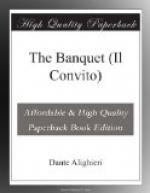revolve round this centre continuously, even as we
see; in which revolution there must of necessity be
two fixed Poles, and a circle equally distant from
these round which all especially revolves. Of
these two Poles, the one is visible to almost all
the discovered Earth, that is, the Northern Pole;
the other is hidden from almost all the discovered
Earth, that is, the Southern Pole. The circle
spread from them is that part of Heaven under which
the Sun revolves when it is in Aries and Libra.
Wherefore, it is to be known that if a stone could
fall from this Pole of ours, it would fall there beyond
into the sea precisely upon that surface of the sea,
where, if a man could be, he would always have the
Sun above the middle of his head; and I believe that
from Rome to that place, going in a straight line to
the North, the distance may be almost two thousand
seven hundred miles, or a little more or less.
Imagining, then, in order to understand better what
I say, that there is in that place a city, and that
its name may be Maria, I say again that if from the
other Pole, that is, the Southern, a stone could fall,
that it would fall upon that part of the ocean which
is precisely on this ball opposite to Maria; and I
believe that from Rome to where this second stone
would fall, going in a direct line to the South, the
distance may be seven thousand five hundred miles,
a little more or less. And here let us imagine
another city, which may have the name of Lucia; and
the distance, from whatever part one draws the line,
is ten thousand two hundred miles between the one
and the other, that is, half the circumference of this
ball, so that the citizens of Maria hold the soles
of the feet opposite the soles of the feet of the
citizens of Lucia. Let us imagine also a circle
upon this ball which is in every part equi-distant
from Maria as from Lucia. I believe that this
circle, according to what I understand by the assertions
of the Astrologers, and by that of Albertus Magnus
in his book On the Nature of Places and on the Properties
of the Elements, and also by the testimony of Lucan
in his ninth book, would divide this Earth uncovered
by the sea in the Meridian, almost through all the
extreme end of the first climate, where there are amongst
the other people the Garamanti, who are almost always
naked; to whom came Cato with the people of Rome when
flying from the dominion of Caesar. Having marked
out these three places upon this ball, one can easily
see how the Sun circles round it.
I say, then, that the Heaven of the Sun revolves from West to East, not directly against the diurnal movement, that is, of the day and night, but obliquely against that, so that its mid-circle, which is equally between its Poles, in which is the body of the Sun, cuts into two opposite parts the circle of the two first Poles, in the beginning of Aries and in the beginning of Libra; and it is divided by two arcs from it, one towards the North and one towards the South; the points




